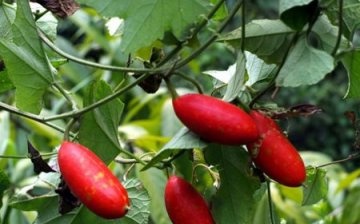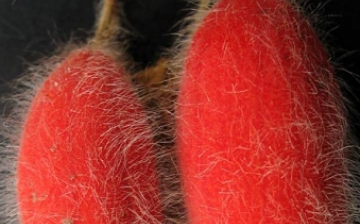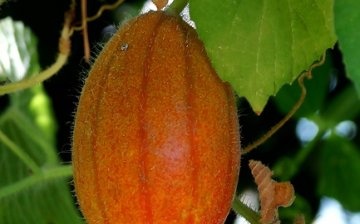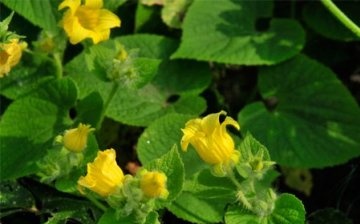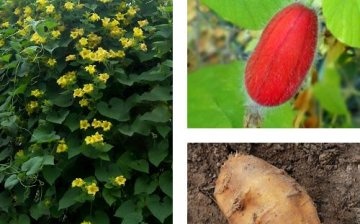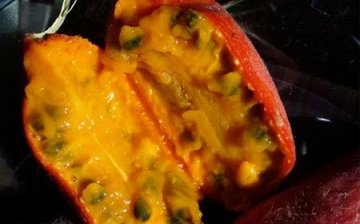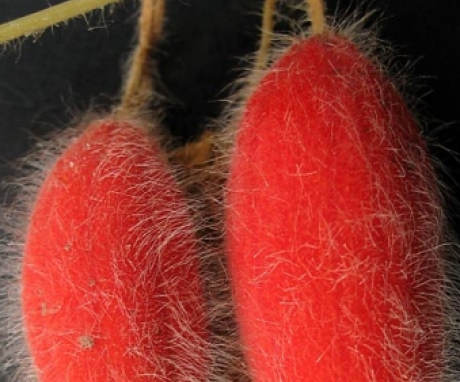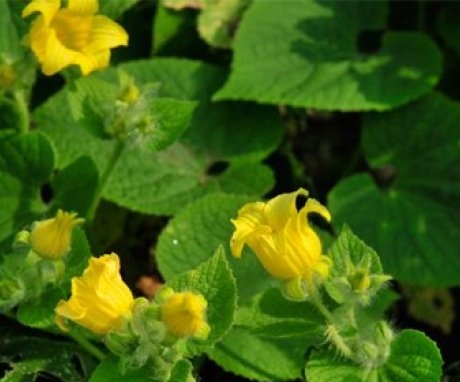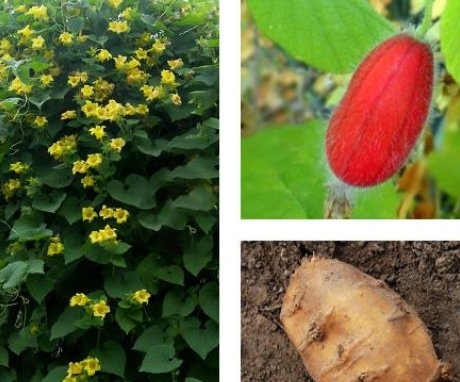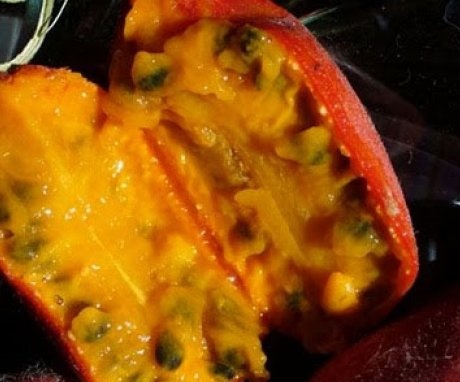Tladianta: description, propagation, reproduction and applied
Tladianta is a perennial plant, according to the botanical nomenclature, it belongs to the pumpkin family, and it is, thus, related to such familiar zucchini and cucumbers. About the origin, she is Asian, to be more precise, in natural nature she was originally found in the Far East - the territory of the Primorsky Territory of Russia and Northeastern China.
Content:
- Botanical features of tladiants
- Description and distribution
- Agricultural technology tladiants
- Reproduction of tladiants
- Application
Botanical features of tladiants
An interesting fact is that I. Michurin, one of the most famous botanists in our country, whose name has become almost a household name, noticed this plant and made successful experiments with it in terms of distant hybridization back in the thirties of the last century. This hero, so interested in our scientist, is a dubious tladiant, or, in Latin, Tladiantha dubia.
Among amateur gardeners, she received the nickname red cucumber.
In fact, this plant represents a liana, and grows just like everyone else habitual ivy or grapes... In nature, the dubious tladiana grows in coastal meadows, among shrubs, on loose sandy sediments of the sea coasts, and also as a weed in gardens and vegetable gardens.
Tladiant in our time is not a widespread culture and has a very limited use especially in decorative purposes in the temperate climatic zone of our planet.
Description and distribution
So, as mentioned above, our red-colored cucumber is a perennial creeping (botanists like to use the term "climbing") vine.
Features:
- Its shoots are in the form of fluffy-hairy stems that creep in length to a distance of 5 meters (gardeners use this so that the length is transformed into height).
- Tladianta is predisposed to branching, and if something to "lean on", then with pleasure it climbs up such a support at the expense of its antennae and grows rapidly.
- This plant has leaves of a light green color, in the shape of hearts, resembles felt in softness, and on the outside they have a small fluff.
- The flowering period of this liana falls in the summer and can drag on even until early autumn.
- In tladians-"boys" flowers are golden-yellow in color, five-part, in the form of a relatively large bells, their petals are slightly bent back. Their size is 2-3 centimeters in diameter, they are collected in inflorescences in the form of brushes.
- Women, on the other hand, are outwardly simpler, not as bright (rather, even "dull" against the background of the former), grow singly and have a flat shape.
The fruits of the tladiant are in the form of an oblong "egg" of green color. It is the color, shape and size that makes them so similar to small cucumbers, which, when ripe, turn red and orange-red with poorly visible stripes.
At first, the fruits, like the leaves, are hairy, but as they ripen, they become smooth, and their interior in the form of a reddish pulp carries up to a hundred hard seeds. They are hairy at first, and then they become smooth. Inside, ripe fruit is dark in color (typically pumpkin).
Under the ground, the shoots of tladians grow into chains of tubers, of a rather large size: in centimeters, the diameter is up to 2, and the length is up to 8.
In nature, tladiant is found in meadows, in thickets of bushes, along the sea and river banks of loose dunes, well, in a garden and a vegetable garden - like a weed.
Speaking about the tladian, first of all, it should be noted that this is an ornamental plant that is not often found in our country, which is distinguished by its rapid growth.
Agricultural technology tladiants
This Asian "cucumber" is extremely unpretentious, like any natural weed plant.
Gardeners prefer to choose sunny areas of their plantations for him (southern or eastern sides).
Tladianta will grow well on non-depleted, loosened and moderately moist soil (loamy is preferred). Watering is required as needed - even in abundant quantities during the dry season. It will not "resist" even if you feed it with natural fertilizers, say, diluted and fermented cow dung, in which you can add a little wood ash and superphosphate.
Reproduction of tladiants
This plant can propagate both by seeds and root tubers by dividing them.
In general, tladiana is characterized by a violent formation from its roots in the form of tubers of new shoots. They are called stolons and in large quantities, these horizontal long shoots can grow over the season over a considerable area of the land. Therefore, for preventive purposes, it is recommended to limit the planting of this plant by digging any obstacles into the soil to a depth of up to half a meter, for example, slate sheets.
Breeding features:
- The division of tubers should be done in the spring after the shoots have appeared, and immediately planted in the soil at the planned place.
- The landing distance is about 50 centimeters from each other, and 20 centimeters in depth will be enough.
- Immediately after planting, the shoots need to grab onto something, so the easiest and best way is to pull the twine along which your plant will "rise upward."
The only difficulty in growing tladiana is the peculiarity of its pollination.
At home, as we remember, this dioecious plant has a personal "friend" for this purpose - the local wild bee. Our nature did not take care of such a comrade, because neither our bees, nor wasps, let alone bumblebees, pollinate the tladian.
In other words, tladianda cultivation will require manual pollination.
It is interesting that not only the male flowers of the plant itself, but also pollen from the most common garden pumpkin plant (the same cucumbers or squash) are suitable as a source of pollen. By the way, the fruit in this case will, of course, be without seeds and with better taste for use in food than the fruit obtained "naturally".
Application
Tladiant is primarily a decorative culture.
Its soft leaves, exuberant (as for a plant of temperate climatic zones) flowering, and in autumn - original and beautiful fruits make a spectacular impression:
- Due to the fact that this plant grows in a matter of weeks, the tladiant will be very appropriate in the case of a random, if there is a need to hide areas of your garden from the views of outsiders that have an unsightly appearance, for example, compost heaps.
- Also, this plant can wonderfully give shade in your gazebo or veranda, it will perfectly cope with decorating arches or even old trees.
- You can use this beautiful vine and how indoor plant in a tub for decorating a loggia or balcony.
- Its lodas are edible. When they are still green, they are suitable for canning or pickling, like cucumbers and zucchini. However, it is still impossible to equate them with the latter, the taste is excellent and there is no need to wait for the usual culinary pleasure.
Ripe fruits have a sweet taste and are suitable for turning into jams and preserves.However, this vegetable still has its own taste, so in cooking it is used more for experimentation and exoticism.
Oriental medicine is also used in tladiante:
- A decoction can be made from tubers and seeds, after insisting which it can be used as a diuretic (its choleretic quality is also known);
- This vine, after proper treatment, is used as an expectorant and astringent;
- A plant from the ancient known to the Chinese as a remedy against scurvy.
- Traditional medicine uses fruits, flowers, grass and seeds of tladians in the treatment of hypertension and flu, with its help relieve headaches.
As you can see, the cultivation of tladians is not intricate, does not require any excessive efforts and a lot of attention from the gardener, and you can get significant benefits.
Tladianta is the simplest and not the most whimsical plant, and as a material for the construction of "green walls" will serve you as a wonderful material, original, moreover, since it is not widespread and not every neighbor has it.
Tladiana is also often called red cucumber. What is the difference between tladiant and ordinary cucumbers can be found in the video.



